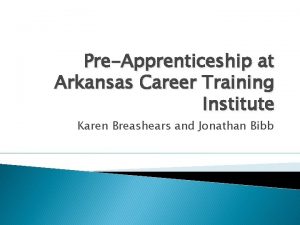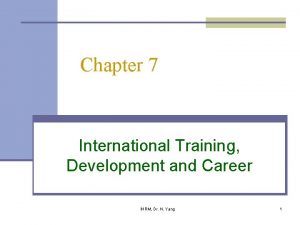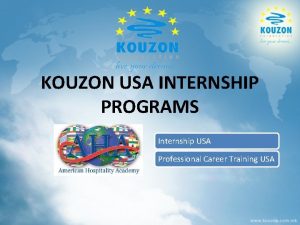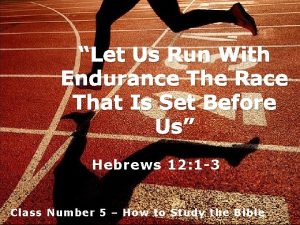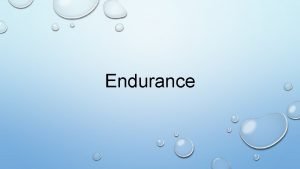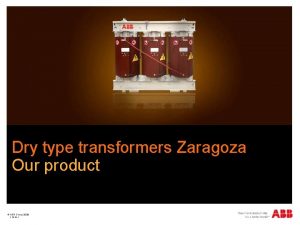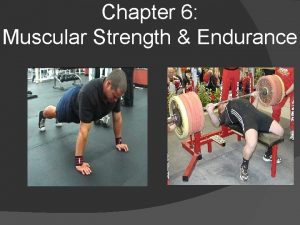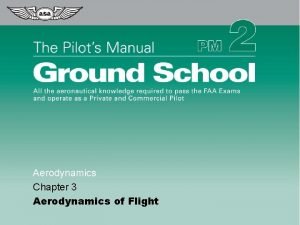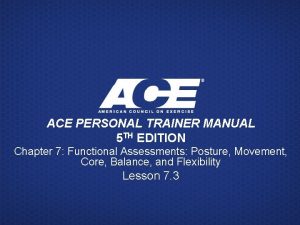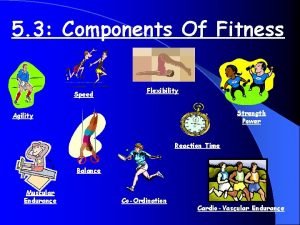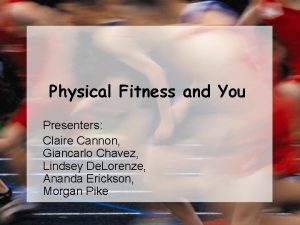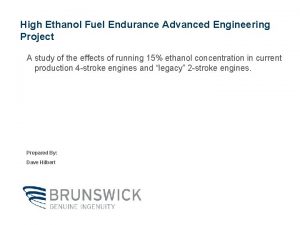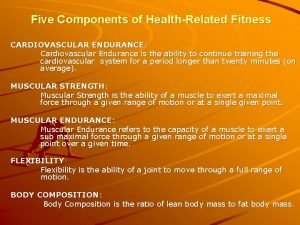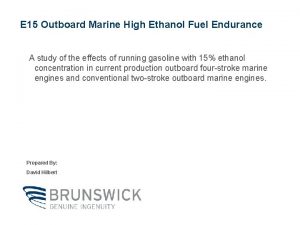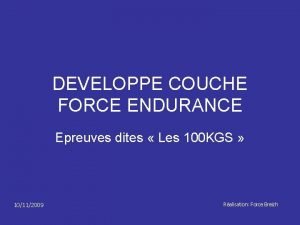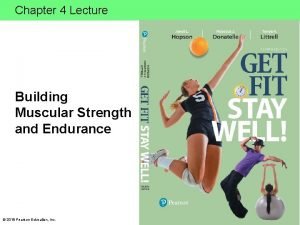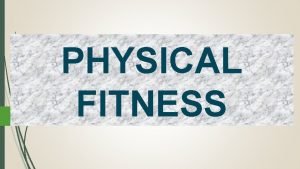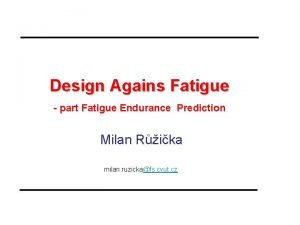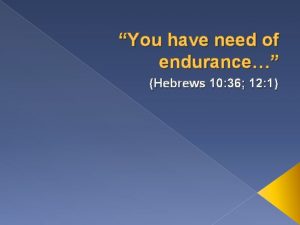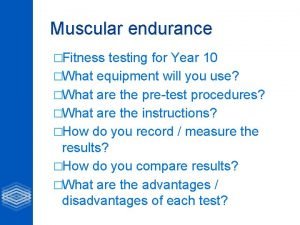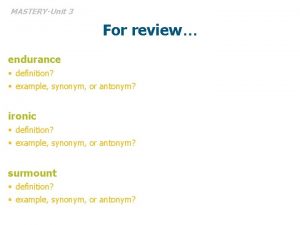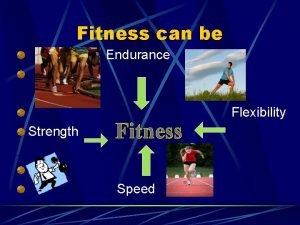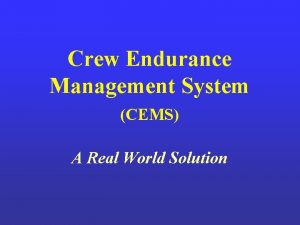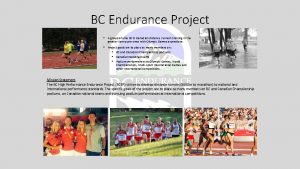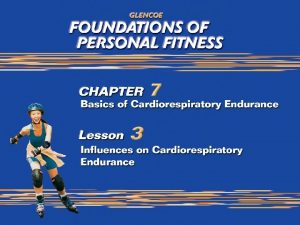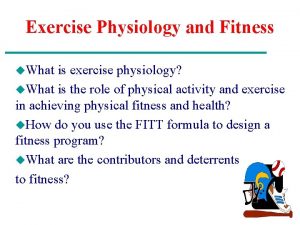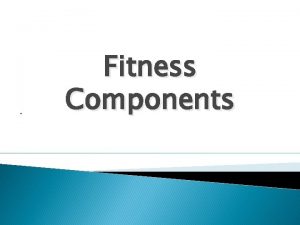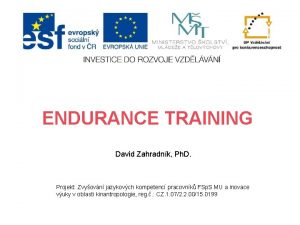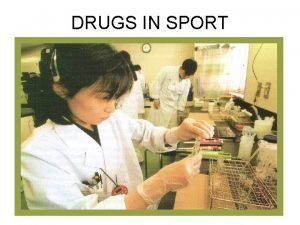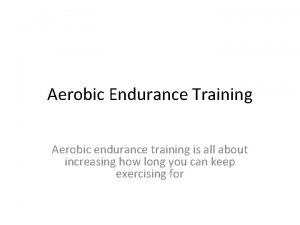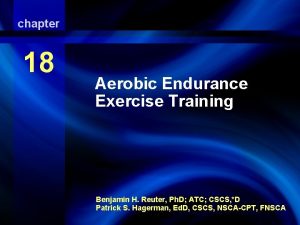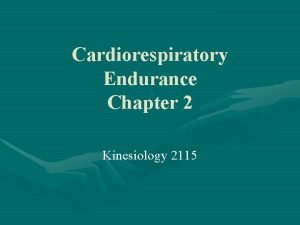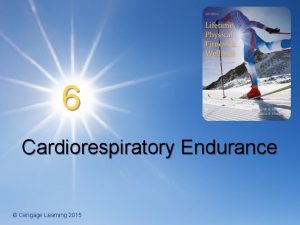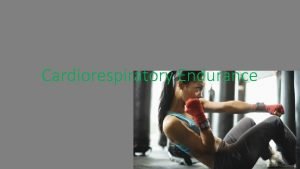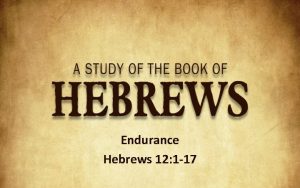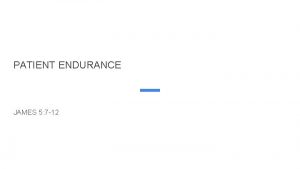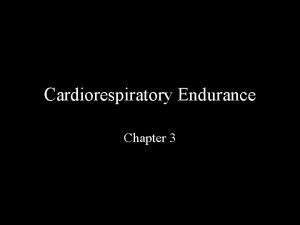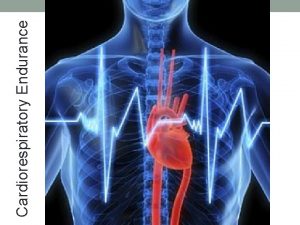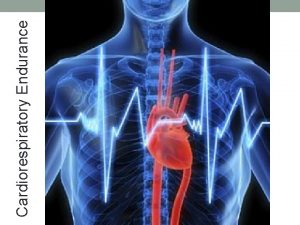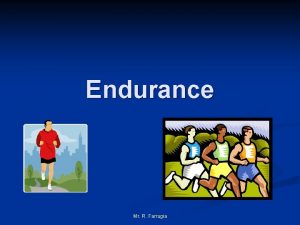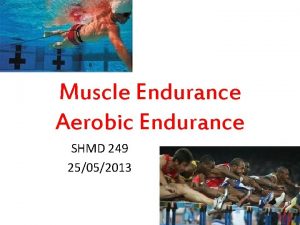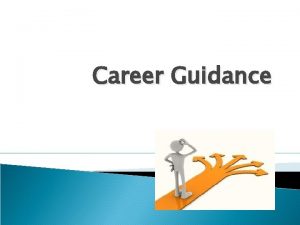Training for Endurance Training for Endurance A Career







































- Slides: 39

Training for Endurance

Training for Endurance A. Career Highlights B. Program Goals and Philosophy C. Culture and Values D. Program Description

Career Highlights • I’m a club coach – only draw talent from a natural catchment area • I’ve been a head coach since 1993 (26 yrs) • In my second year as a head coach I developed two FINA “A” girls who made the Pan Pac team, which was also my first senior team • I’ve made: § § § 3 Olympic teams (1996, 2012, 2016) 2 World Championship Teams (LC) (2009, 2011) 2 Commonwealth Games Teams (1998, 2002) 3 Pan Pac Teams (1995, 1999, 2006) 3 Junior World Championship Teams (2006, 2011, 2013) 4 Junior Pan Pac Teams (2009, 2010, 2014, 2018)

Career Highlights I’ve coached national champions in 4 different countries § § Riley Mants – U. S. Nationals 1996 LC 200 Breaststroke Tobias Oriwol – British Nationals 2004 SC 200 I. M. Francesco Zuccaro – Italian Nationals 2008 LC 800 Freestyle 18 Canadian National Champions 12 high school-aged FINA “A” Qualifiers Including four Olympians § Riley Mants – 200 Breaststroke 1996 § Jenna Gresdal – 50 Freestyle 2000 § Alexa Komarnycki – 400 I. M. 2008 § Brittany Mac. Lean – 400 Freestyle 2012

Career Highlights Only Canadian coach to have coached 2 medalists at the Youth Olympics § Lauren Earp – 100 Freestyle Bronze 2010 § Alexander Milanovich – 50 Breaststroke Bronze 2018 Only Canadian coach to have coached 2 Gold medalists at the Junior Pan Pacs and/or Junior World Championships combined § Hassaan Abdel-Khalik – 2009 Junior Pan Pacs 200 Freestyle § Britanny Mac. Lean – 2011 Junior World Championships 200, 400 Freestyle 6 Junior World Championship Finalists + Alex M. Hanna Henderson – Most medals (12) at a single Canada Games (2017) Hassaan Abdel-Khalik – Only swimmer to hold all records simultaneously in every Olympic freestyle event in a particular age group (15 -17 SC)

Career Highlights Amanda Reason – World Record 50 Breaststoke LC 2009 Brittany Mac. Lean – 2 -time Olympic finalist 400 Freestyle (2012, 2016) Olympic Bronze Medallist 4 x 200 Freestyle (2016) 2014 Canadian and NCAA Female Athlete of the Year 13 swimmers placed on Junior World Championship teams since 2006 9 swimmers placed on Junior Pan Pac teams since 2009 Carrie Burgoyne – 7 th SC World Championships 1997 400 I. M. (15 y. o. ) Olivia Anderson – 7 th SC World Championships 2016 800 Freestyle (17 y. o. ) Kelly Stefanyshyn – Silver medal Commonwealth Games 1998 100 Back (16 y. o. )

Career Highlights ESWIM currently holds all but 1 LC Girls’ Ontario relay records from 11 -12 up to and including the open category (19 out of 20) ESWIM currently holds 44. 7% of all female age group national records (combined relay and individual) with a total of 51 records Next closest club is Toronto Swim Club with 8. 8% (10 records) ESWIM currently has the most male age group national records with 11. 4% Cascade is second with 10. 5% (there’s never been a club that has super-dominated the male records) ESWIM currently holds 76% of all girls’ national relay records 11 -17 (23 out of 30) Why count Records? – Cutting edge, highest level of excellence Why relays? – Speaks to depth

1. 2. 3. 4. 5. 6. Program Goals and Philosophy Afford an opportunity for all members of the club to excel. Swimmers should derive happiness from the pursuit of excellence. “Swimming should be an adventure, not an ordeal” – Bob Bowman Have athletes at their best in their prime. Be the best club team we can be without putting team first. Create all-rounders before specialization. • Specialization should be appropriately timed. 7. Create as many swimmers as possible with “the range”. (100 -1500) 8. Try to have everyone in each group swimming to their potential, not focusing only on the talent.

Program Goals and Philosophy 9. Continue to develop FINA “A” swimmers at a minimum rate of 1 every 2 years, i. e. not just waiting for talent to appear in the program. 10. After a period of general development, run programing to allow for specialization, including the extremes, but the mid/dis ethic must dominate. 11. General development phase is aerobic Free/I. M. training (Unlike the sprinters, those swimmers who will eventually become mid/dis swimmers get to prepare in their specialty area from the beginning of their swimming careers. ) - Identify “drop-dead” sprinters, make some adjustments 12. Character development. 13. General physical development. 14. “Don’t screw the best for the sake of the rest. ” – Paul Bergen

Culture and Values Possibly the most important thing you can establish as a coach. What do you value most? § Winning? § Keeping everyone happy (including parents)? § Minimizing injuries? § Technique? § Growth and development? § Effort? § Honesty? § Work Ethic/Attendance?

Culture and Values I value work ethic and effort (grit) the most. Use of t-shirt slogans to remind swimmers of our values i. e. “hard to beat heart”, “no excuses”, “do what it takes”, “persist” ESWIM is a “work ethic” club not an “underwater kick” club. You have to choose one or the other, hard to do both. Randy Bennett – “Hard to have more than one focus. ” Clash of cultures Sprinters vs. mid/dis Mid/dis is vastly a greater number of athletes and generally have a higher degree of work ethic. The process is: not fitness first, not technique first, it’s both at the same time. We don’t work on technique to the detriment of development. Technique must be sustainable under duress.

Culture and Values Coaches’ and Swimmers’ attitude towards: E-Z vs. Hard Improvement E-Z Improvement is everything that does not deal with pain - Diet, sleep schedule, time management, lifestyle, technique work Hard Improvement occurs with pain - Hard work – training effect (water and dryland) E-Z improvement risks unrealistic rise in a swimmer’s personal expectations/goals.

Culture and Values Order of questions parents should ask their swimmers after a race: 1. Did you give a 100% effort? 2. Did you swim the race the way you wanted to? 3. What did you learn from the race? 4. Did you swim a best time? 5. What place did you come in the race? • Questions start with intrinsic and move to extrinsic. Creation of team atmosphere and protection of excellence environment: • AM Rule • Dryfits for all drylands, pre- and post-water • White ESWIM caps only for training

Program Description Free/I. M. -based before specialization Why freestyle? – crossover effect Work ethic is the guiding principle Speed within an aerobic context – NBAC Race Pace Modal vs. Physiology Modal - O. A. 15 x 100@1: 20 avg. 1: 04

Program Description Concurrent training model – “a weekly blend of energy systems” Monday Tuesday Wednesday Thursday Friday Saturday Sunday AM Aerobic OFF Power Circuit OFF EZ Aerobic Longer Aerobic (Spr/Speed) OFF PM Aerobic/ Max VO 2 Higher Rest Race Pace Aerobic/ Max VO 2 OFF § I. M. Weekly Cycle § Dis Weekly Cycle § Macro Cycles?

Program Description 400 I. M. Development - Add the four stroke 200 s – goal-setting rule of thumb - i. e. - 2: 12 2: 14 2: 38 2: 02 = 9: 06 ÷ 2 = 4: 33 add : 10 for girls add : 12 -: 14 for boys Predicted time for the girl 4: 43 For the boy 4: 45 -4: 47

Program Description Long Course Training 2 -3 sessions per week Training camps tend to do more (80%-100%) Too much LC can dull down your swimmers Training SC makes it easier to maintain race stroke rates And general training intensity NBAC – “We’re training SC yards to race LC metres” Training “the Range” – train primarily for the 400, but do enough speed and endurance work to be able to race successfully in the 100 up to the 1500 Max. VO 2 training – Free is 100 pace of 400 Fr - Strokes are double 200 time and add 12 -14 seconds - Whatever 25% of that sum is, is the 100 training pace

Program Description Things our young swimmers focus on 1. Learning as much as possible about the sport of swimming – laying the foundation for Senior Competition and Success. (i. e. success at age group competitions is not intended to be a goal unto itself) 2. Training with better and better technique on faster and faster intervals 3. Learning how to deal with close quarter racing 4. Learning how to handle residual fatigue from training – usually starts when doubles are introduced into the training program 5. Learn how to maintain good technique while fatigued 6. Introduction of lifestyle information intended for long term development

Krisztina Egerszegi 100 back Program Description 200 back 400 IM 200 fly 200 free 200 IM 400 IM Michael Phelps 100 fly 100 free Katie Ledecky – 100 free – 1500 free Hassaan Abdel-Khalik – 50 free – 1500 free

Program Description “Building the Engine” – cardiovascular system - Takes years to develop, most people do “too little, too long” Advanced, Elite, Junior National groups - use similar weekly cycles - use similar set constructions - a good set needs to be 3 -5 k or bigger - within a context of progressive loading - minimal high-rest sprints with young swimmers - minimal tapering for competitions - don’t over-program meets - Maximum Heart Stroke Volume – Max vol per beat - 200 max HR 195 max cardiac output 185 -190 MHSV Aerobic range HRs increase the size of the heart, not MHSV

Program Description Group Structure The goal is to have the most compatible training groups as possible Age is a secondary factor Typical girl will enter my group at 13 -14, boys 14 -15 The goal is to be able to coach a talented girl (or boy) for at least one quadrennial – BMac 14 -18 yrs. From 2008 -09 to 2011 -12 Q: How long does it take a swimmer to get into the Head Coach’s group? - We have 3 move-up periods per year Q: How much control do you exert over the volumes your assistant coaches are doing?

Program Description Group Move-Up Criteria 1. Coachability – ability to follow instructions 2. Ability to learn – capacity for change 3. Student of the sport – do they ask questions 4. Team player – displays respect for teammates, coaches, and officials 5. Work ethic – willingness to complete all aspects of training in the manner intended by the coach 6. Power to weight ratio 7. Display a growing commitment to the sport of swimming 8. Display appropriate skill level to progress to the next skill level 9. Attendance – perfect attendance is encouraged and is necessary to become a true elite athlete 10. Future prospects 11. Display ability and interest in multiple events is an asset

Program Description

Program Description

Program Description

Program Description Mileage Progression of Typical Athlete 70 60 50 40 30 20 10 0 Km / week TB (8) TA (9) Jr. A(10) Adv(11) El(12) JN(13) HP(14) HP(15) HP(16) HP(17) HP(18)

Program Description Bell Curves – the “Natural Distribution” Genetic Suitability by Event 10 8 6 4 2 0 50 100 Fast twitch 200 400 800 1500 Slow twitch Bell Curves There is a bell curve for every event by gender and age Any one parameter in nature falls on a bell curve When looking at an event from one year to the next, “The times stay the same, but the names change” Bell Curves move slowly over time to the right

Sample Sets A) Long aerobic / Assorted __x 400 Free Alternating 1 x. Swim EZ @6: 00 / 1 x. Pull Descending @ 5: 30, 5: 20, 5: 00… 4: 30 or 4: 20 Objective: Descend pull 400 s to goal interval Rule: If swimmer fails to beat any pull interval, they must swim the remaining pull 400 s. If they fail to meet the pull intervals while swimming, they put on fins to complete the set. Equipment changes are done after EZ swim 400 s. 2 K I. M. (5 x 400 I. M. back to back) usually done SC, always with full stroke Fly. SE – 25: 21(5: 04 avg) “Cancun Set” 2 x 50@1: 15 (25 F/25 EZ) 2 x 50 (1@: 50 200 RP / 1@1: 10 Cruise between : 33 -: 36 Fr) 1 x 100 Fast @1: 30 (Goal is to be at or faster than back half of 200 LTB)

Sample Sets B) Turn and go / Pyramids Flying Wedge 100 Pace 2: 00 1: 30 1: 20 1: 15 1: 12 1: 10 1: 08. 9 1: 07. 5 Interval 2: 00 3: 00 4: 00 5: 00 6: 00 7: 00 8: 00 9: 00 --> 100 200 300 400 --> 100 200 300 400 500 600 700 800

Sample Sets B) Turn and go / Pyramids Cosmic Wedge – Read down by column (100, 200, 300, 400, 500…) 100 @ 2: 00 200 @ 3: 00 300 300 400 400 500 500 @ 4: 00 @ 5: 00 500 @ 6: 00 Wedge Principe – Read down by column (500, 400, 300, 200, 100…) 500 400 300 300 200 200 100 100 100 Interval 100 Pace 7: 05 1: 25 5: 20 1: 20 3: 45 1: 15 2: 20 1: 10 1: 05

Sample Sets C) Straight Set – Short Rest 12 x 400 Free swim @Best interval + Best average MS – Interval 4: 40 Avg 4: 32 (SC) 30 x 100 Free swim @1: 20 Best Average (SC) SE 1: 04 BMac 1: 04 15 x 100 Free swim @1: 30 Best Average HAK : 58. 00 (SC) 10 x 150 Free Pull @2: 20 Best Average (Buoy/Band) BMac (LC) 1: 41. 7(2011), 1: 38. 5 (2012)

Sample Sets D) Recovery Check 3 Heart Rates: 1 Immediate 1 +1 Min 1 +2 Min Ex. 185 135 -140 105 -120

Sample Sets E) Kick Test Sets 1. 50 k for time 2. 100 k for time 3. 200 k for time 4. 400 k for time 5. 800 k for time 6. 1500 k for time 7. 10 x 100 @ 2: 00 k Best Avg. 8. 10 x 50 @ 2: 00 k Best Avg. 9. 16 x 50 @ 2: 00 k Best Avg. 10. 16 x 50 @ 1: 30 Weight Belt K Best Avg. 11. 4 x 300 K @ 5: 00 Best Avg.

Sample Sets F) Skill and Pace Test Sets 1. 2. 3. 4. 5. 6. 7. 15 x 50 @ ___ descend 1 sec per 50 m 8 x 50 @ 1: 30 stroke and time add-up 12 x 50 pull @ 2: 00 Best Avg. 12 x 50 swim with small paddles @ 2: 00 Best Avg. 5 x 50 @ 3: 00 descend 1 -5 to max, take stroke counts – “efficiency test” 5 x 200 @ 4: 00 (5: 00 breast) “step test” 40 x 50 – 5 x 4 x 50 Cruise @ : 55 can be free 4 Stroke @ : 50 Best Avg. Rec. Sr Counts (SMc Fly LC : 34 / 30) 8. 40 x 50 – Alt. 1 x 50 @ 1: 20 200 R. P. +5 get stroke count 1 x 50 @ 1: 10 200 R. P. -1 get stroke count 9. 25 for time full Power Tower bucket (AM : 22 for breaststroke)

G) Aerobic Endurance Test Sets Sample Sets 1. 2 k I. M. for time (5 x 400 I. M. back to back) 2. 3 k Free for time 3. 5 x 400 Free @ best interval and Best Avg. 4. 1500 stroke for time 5. 5 x 400 stroke or I. M. @ 6: 00/6: 30/7: 00 Best Avg. (approximately 1 min. rest) 6. ___ x 100 Free @ best possible interval (up to 20 max) 7. 13 out of 13 add-up (@ one minute rest between swims) 8. 8 x 200 stroke @ best interval Best Avg. 9. 3 x 1500 @ 20: 00 Best Avg. 10. 3 x 1500 @ best interval Best Avg. 11. 5 x 800 @ 12: 00 Best Avg. 12. 5 x 800 @ best interval Best Avg. 13. 3 x 800 @ 9: 30 Best Avg.

Sample Sets G) Aerobic Endurance Test Sets 14. 20/30 x 100 @ 1: 20/1: 30 Best Avg. 15. 3 x 400 Free @ 5: 00 Best Avg. 16. 10 x 300 Free @ 4: 00 Best Avg. 17. 15 x 400 Free @ 5: 30 Best Avg. SC 18. 10 x 400 Free @ 5: 00 Best Avg. SC 19. 5 x 400 Free @ 4: 30 Best Avg. SC

Sample Sets H) Aerobic Power Test Sets 1. 2. 3. 4. 5. 6. 7. 8. 9. 10 x 150 Free @ 3: 00 for add-up 1500 10 x 150 Free Pull @ 2: 20 Best Avg. – Buoy/Band only 8 x 100 Choice @ 1: 10/1: 15/1: 30/1: 40 Best Avg. 12 x 75 Choice @ 1: 30 Best Avg. 10 x 100 FINS @ 2: 20 Best Avg. Breast or Fly (SMc 1: 05. 7 Avg. LC) 20 x 50 FINS @ 1: 10 Best Avg 6 x 100 @ 1: 30 Best Avg. dive #1 10 x 200 @ 3: 00 Best Avg. (Free or Stroke) 5 x 200 Choice @ 5: 00 Best Avg. from dive

Sample Sets All-Time Best 5 x 200 @ 5: 00 Test Set Women Short Course 2: 04. 3 Alexa Komarnycky 2: 22. 2 Alexa Komarnycky 2: 36 Riley Mants 2: 25 Monika Stitski 2: 19. 8 Alexa Komarnycky Stroke Freestyle Backstroke Breaststroke Butterfly I. M. Men Women Short Course Long Course 1: 55. 0 2: 10. 6 Francesco Zuccaro Marylyn Chiang 2: 07. 2 2: 19. 0 Richie Stokes Meryn Mc. Cann 2: 34. 2 2: 39 Bogdan Knezevic Riley Mants 2: 13. 4 2: 28 Adam Pendry Kristy Mac. Lennan 2: 14. 5 2: 26 Tobias Oriwol Carrie Burgoyne Men Stroke Freestyle Backstroke Breaststroke Butterfly I. M. Long Course 2: 00. 0 Francesco Zuccaro 2: 16 Tobias Oriwol 2: 37 Andrew Chan 2: 16. 5 Thomas Jobin 2: 19 Owen Mac. Gregor

Sample Sets I) Critical Speed and Race Pace Test Sets 1. 20 x 50 Choice @ 1: 00 Best Avg. 2. 15 x 100 Choice @ 2: 00 Best Avg. 3. 10 x 150 @ 4: 00 Best Avg. (can be Free/Stroke/I. M. combo) 4. 8 x 100 Choice @ 4: 00 Best Avg. from dive 5. 6 x 50 Free or Fly @ 6: 00 minimum breaths – goal is 0 breaths for the set, including penalty breaths 6. 10 x 50 Choice @ 3: 00 Best Avg. from dive 7. 12 x 50 Choice @ 2: 00 Best Avg. from dive 8. 16 x 50 Choice @ 1: 30 Best Avg. from push 9. 20 x 50 Choice @ 1: 00 Best Avg. from push 10. 10 x 100 @ 3: 00 Best Avg. Free or Stroke 11. 6 x 100 @ 6: 00 from dive – to complete set, 6 within 6 or 5 within 5 or 4 within 4 3 within 3 or 2 within 2 or 1 within 1 11. 8 x 100 Free @ 2: 30 Best Avg. SC (test set for entire club)
 17 career clusters
17 career clusters Formulas for career success career testing & investigation
Formulas for career success career testing & investigation Arkansas career training institute
Arkansas career training institute International training development and careers
International training development and careers Education and training career cluster definition
Education and training career cluster definition Professional career training usa
Professional career training usa Career guidance training
Career guidance training Differentiate muscular strength from muscular endurance
Differentiate muscular strength from muscular endurance Tinman running calculator
Tinman running calculator Let us run with endurance the race that is set before us
Let us run with endurance the race that is set before us What is endurance
What is endurance Resin cast potential transformer
Resin cast potential transformer Fitt table muscular strength and endurance
Fitt table muscular strength and endurance Stall speed increase with bank angle
Stall speed increase with bank angle Rombert test
Rombert test Static balance in sport
Static balance in sport Claire cannon
Claire cannon Haydee endurance test
Haydee endurance test What are the components of fitness?
What are the components of fitness? Haydee endurance test
Haydee endurance test Endurance de force cometti
Endurance de force cometti Venn diagram of muscular strength and endurance
Venn diagram of muscular strength and endurance Fitness is defined as
Fitness is defined as Mapeh grade 7 health
Mapeh grade 7 health Perdurance theory
Perdurance theory Endurance limit
Endurance limit For you have need of endurance
For you have need of endurance Randfontein mogale endurance ride
Randfontein mogale endurance ride Special endurance
Special endurance One minute press up test normative data
One minute press up test normative data For example synonym
For example synonym Be endurance
Be endurance Endurance management group
Endurance management group Bc endurance project
Bc endurance project Describe cardiorespiratory endurance
Describe cardiorespiratory endurance Difference between strength and endurance
Difference between strength and endurance Isometric vs isotonic
Isometric vs isotonic Local muscular endurance definition
Local muscular endurance definition Endurance trainig
Endurance trainig Regina high performance endurance
Regina high performance endurance


